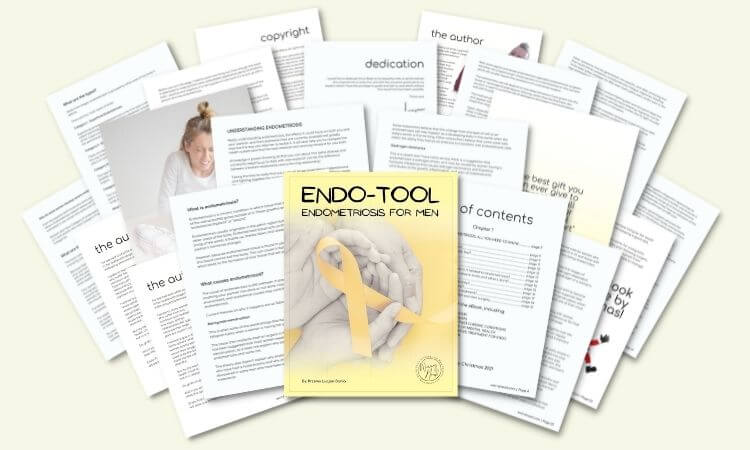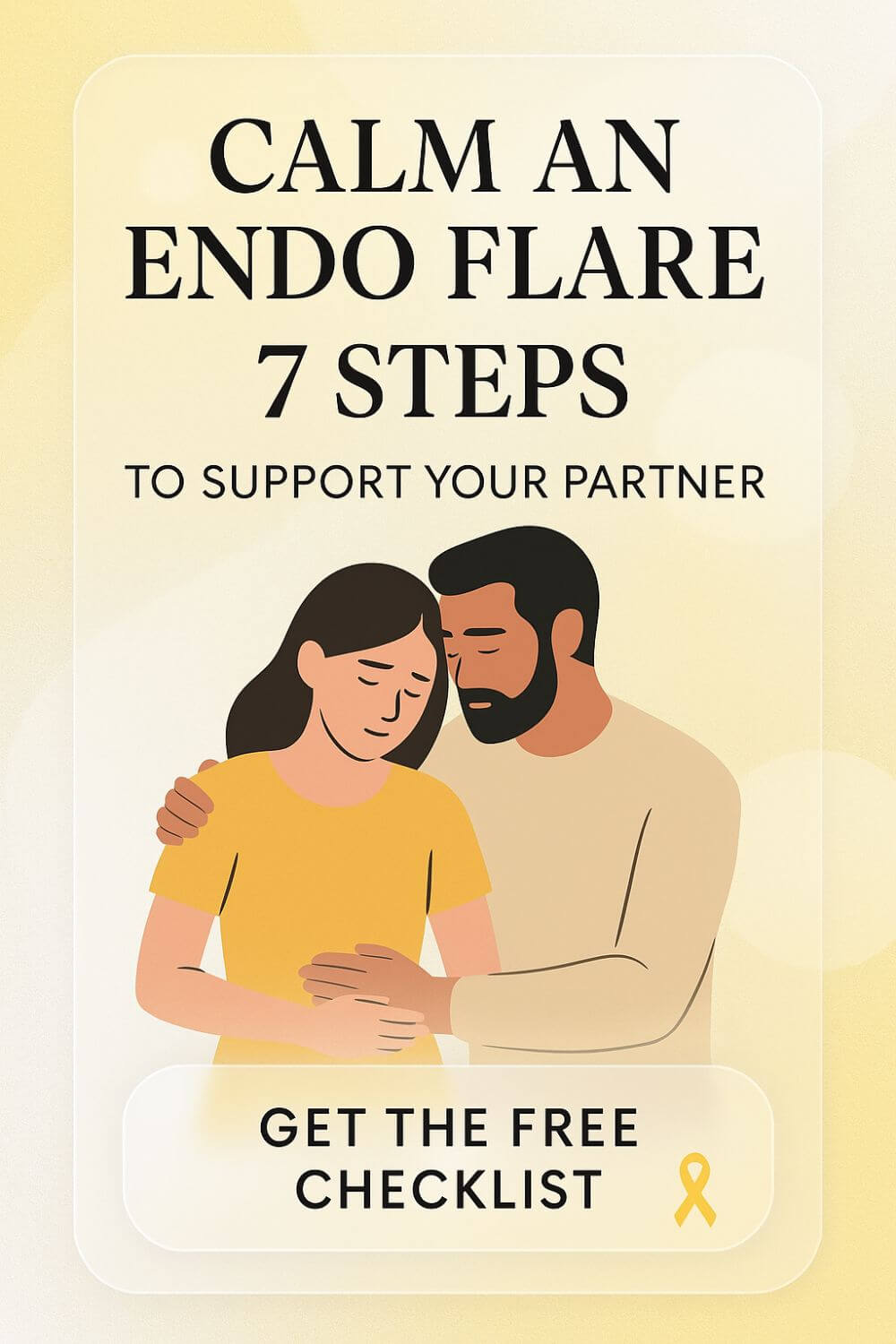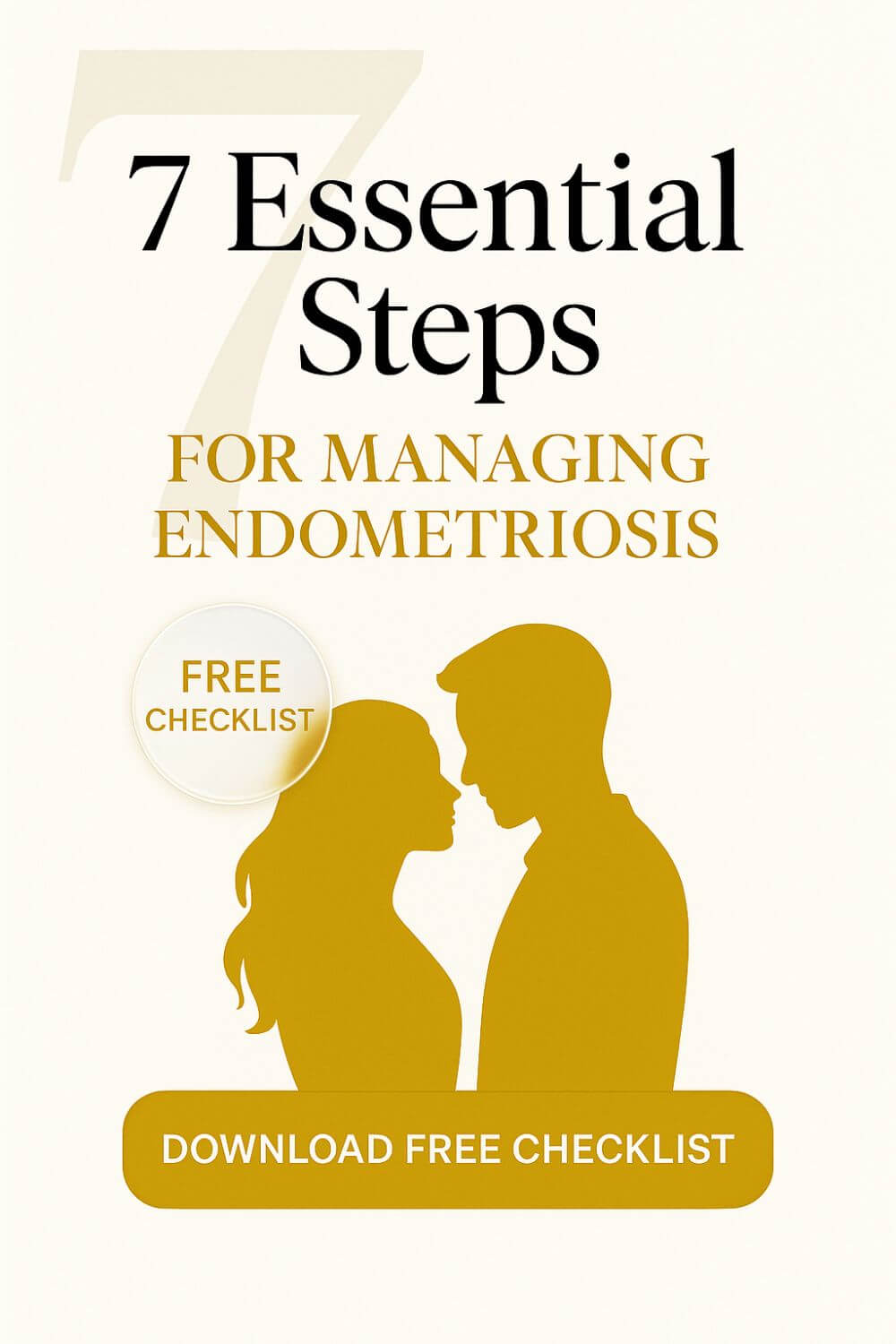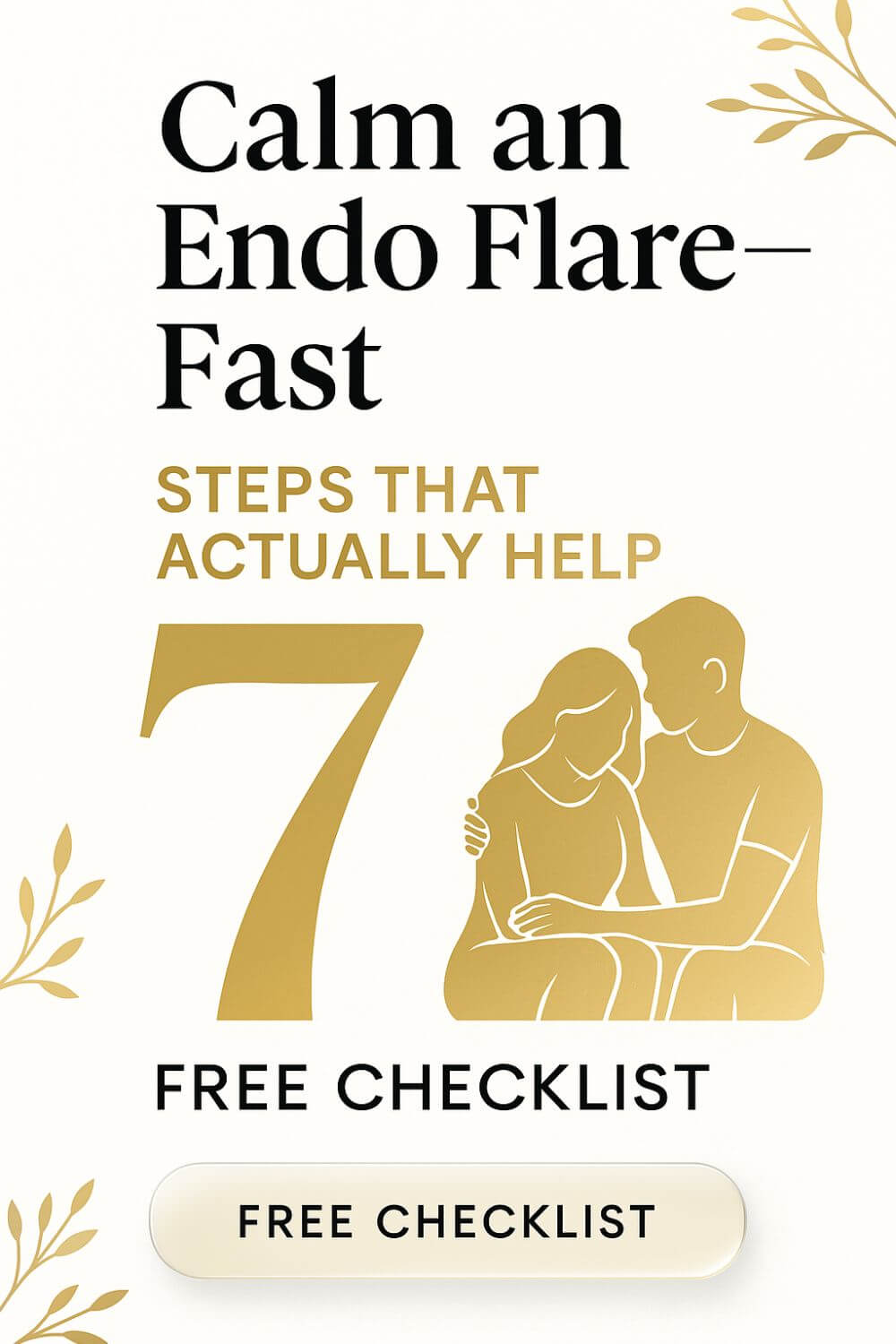Endo Flare Up Routine
Some nights I sit beside my wife, watching her breath hitch as waves of pain rise and fall, and I remember how helpless I once felt. What can you do during an endo flare up that truly helps when everything hurts and time slows?
A reliable endo flare up routine starts with heat and low-stimulus rest, guided breathing, hydration, and gentle positioning, then adds symptom tracking and clear red-flag rules for seeking care. Prepare a small go-bag and partner scripts so relief steps become automatic, repeatable, and calm.
When ovarian pain spikes or endo belly makes even soft waistbands unbearable, a simple sequence can steady the moment and protect your energy. I’ve learned to move first, explain later, cut the lights, set the heat, guide the breath, and guard the room.
You deserve a plan that turns panic into predictable care, even on the hardest days of living with chronic pain.
Want practical help right now? Grab a FREE chapter of my eBook and join our community, get more freebies, big discounts on our books, and honest emails that make the new normal a little softer and a lot more doable.
The first chapter alone contains all the comprehensive medical knowledge about endometriosis, including:
- What is endometriosis?
- What are the symptoms?
- What causes endometriosis?
- What does endometriosis look like?
- What are the stages?
- What are the types?
- What is adenomyosis, and how is it related to endometriosis?
- Why do some women develop severe endo and others don’t?
- Does endometriosis cause infertility?
- How is endometriosis diagnosed?
- Do types and stages affect the treatment?
- Recurrence of endometriosis after excision surgery.
FREE Chapter of “Endo-Tool”
Endometriosis e-Book for Men

How to Navigate an Endo Flare Up?
When pain spikes, the goal is steadiness: reduce stimulation, add predictable comfort, and protect energy. Two or three calm moves done in order can change the entire trajectory of a difficult hour.
Start with the environment. Dim the lights, mute notifications, and lower the noise so the nervous system isn’t fighting extra battles. Heat helps pelvic muscles relax; place a heating pad or hot-water bottle where it eases ovarian pain, and check in before adjusting.
Positioning matters. A side-lying curl with a pillow between knees can reduce pelvic pressure; some prefer knees-to-chest briefly, then a gentle recline. Move slowly, breathe slower.
Breath is a lever we control. Counted exhales lengthen the out-breath and downshift the body from alarm toward safety. Try a soft in for three, out for four, repeating for a minute.
Fuel the basics. Tiny, nausea-safe snacks, plain crackers, banana slices, warm ginger tea, steady blood sugar without upsetting a hormonal belly. A few sips of electrolytes can help if appetite is low or there’s iron deficiency or anemia fatigue.
Name what’s happening. Simple, specific words, stabbing, dull, right-sided, worse when moving, guide the next step and keep partners aligned. If bowel symptoms mimic IBS symptoms in women, note that too; patterns matter later.
Guard the door. One person runs interference with phones, deliveries, or pets so the room stays quiet. Small shields prevent big setbacks.
If you’re early in recovery after laparoscopic surgery, respect pacing. Shorter heat sessions, careful positions, and medication timing protect wounds and support laparoscopic surgery recovery. Post-surgery tenderness changes the playbook; gentler is smarter.
Track context. Cycle day and the ovarian cycle phase often shift the pain character and timing. Logging a few details today makes tomorrow less mysterious.
Food is a long game. Many find that an endo diet, less ultra-processed food, and being mindful of triggers, reduces background inflammation over time, but no one needs perfection during acute pain. Compassion first, tweaks later.
Prepare when calm. A small go-bag with a meds list, pads, spare underwear, snacks, and contacts saves decision energy when thinking is hard. Confidence grows from readiness.
Use clear “stop” rules. If pain escalates despite several steps, or new symptoms appear, switch from home care to evaluation. It’s a strength, not a failure, to change course.
Above all, respond before you explain. Reassure, then narrate the next tiny step. Safety is felt before it’s understood.
I learned this by sitting on the floor beside my wife, counting breaths, and matching her pace until the room got quiet again. If you’re reading this alone at 2 a.m., please know someone has been where you are, and there is a path through.
Below is the simple, human list we follow when the world tilts, so use it as your own steadying hand:
- Positioning and steady heat protocol
- Guided breathing with simple counting
- Pain-language mirror and consent scripts
- Nausea-safe snacks and hydration timing
- Sensory controls for light, noise
- Red-flag scan and safety rules
- Post-flare repair and gentle logging

Positioning and Steady Heat Protocol
Start by lowering stimulation and guiding the body into a side-lying curl with a pillow between the knees. This reduces pelvic pressure and can soften ovarian pain that shoots into the back or thigh. If endo belly makes waistbands unbearable, loosen clothing and slide a warm hot-water bottle under the lower abdomen. Keep the heat to a safe, steady warmth and check in before adjusting.
After two to three minutes, encourage a slow roll to the other side to avoid a single pressure point. Gentle diaphragmatic breaths help the pelvic floor release while heat eases muscle guarding. If nausea rises, elevate the chest and head a little and try a soft blanket over the hips.
During an endo flare up, position and heat are not cures, but they buy calm. Small shifts create signals of safety the nervous system can trust, which is often the difference between spiraling and settling.
Guided Breathing with Simple Counting
Breath is a lever you can move when nothing else wants to. I sit at my wife’s pace and invite a quiet in-two-three, out-two-three-four. The longer exhale nudges the body from alarm toward rest, lowering the volume on pain signals. If she nods, we do two or three cycles, pause, then repeat.
When cramps bite hard, I add a “hand on belly” cue so air travels low, not high in the chest. If dizziness appears, we shorten counts. Pair the breath with heat, and the room gets quieter. Over weeks, this practice becomes a reflex you can summon under stress.
It won’t erase lesions or stop the ovarian cycle, but it can unhook the panic that amplifies pain. That’s real power when living with endo and choosing steadiness over fear.
Pain-Language Mirror and Consent Scripts
The words we use shape care. I reflect back what I hear: “Stabbing, right side, worse when moving.” Then I ask, “Touch or no touch?” Consent first, always. If touch helps, I place the heat where she points and ask, “Higher or lower?” This mirror keeps us aligned and prevents unhelpful fixes.
Specific language guides decisions later. If cramps change to deep pelvic pressure with bowel urgency, we note it; patterns can separate endo symptoms from IBS symptoms in women. If pain migrates to the shoulder tip on the right, we treat it as a flag to monitor closely. Validation is medicine, too.
Being believed reduces stress chemistry and supports everything else we try. It is simple, human, and essential in any set of endo flare up tips.
Nausea-Safe Snacks and Hydration Timing
Pain drains blood sugar and appetite, and nausea makes choices small. We plan micro-snacks that go down easily: crackers, rice cakes, banana slices, and warm ginger tea. Two sips of electrolytes, then pause. If there’s known iron deficiency or anemia fatigue, we note it for the next calm day’s plan, not during the spike.
After abdominal surgery or during laparoscopic surgery recovery, the gut can be sensitive. We keep portions tiny and space them. If reflux stirs, we elevate the torso and swap to lukewarm fluids.
Food is not a cure, but stable glucose can blunt dizziness and reduce the sense of free-fall. Over time, an endo diet, personalized and gentle, may lower background inflammation. During the storm, kindness first, quantity second.
Sensory Controls for Light and Noise
The nervous system is already overloaded. We dim lamps, close curtains, silence notifications, and use a soft eye mask if she wants it. I keep conversation minimal and slow so her brain isn’t parsing extra data. If sound travels, a white-noise track can cover door knocks or traffic.
Temperature matters. Too warm can spike nausea; too cool can tighten muscles. We aim for neutral with a light blanket over the hips for comfort. Pets wait outside unless their presence truly calms. These choices look small, but they stop a hundred tiny stressors from piling onto one painful hour.
With sensory peace, heat, and breath do more work, and the room becomes a place the body can trust again.
Red-Flag Scan and Safety Rules
Most flares settle with home steps, but some demand evaluation. We scan quickly: fever, fainting, rigid abdomen, black or bloody stools, uncontrollable vomiting, or new right-sided chest or shoulder pain that could hint at thoracic involvement. If pain stays at seven or higher for an hour despite position, heat, and breath, we call the provider.
After post post-surgery phases, any wound changes, severe swelling, or calf pain push us toward urgent care. We keep a meds list, allergy notes, prior endo surgery details, and contacts ready in a small folder. This is not fear; it’s clarity. Having rules removes the debate when thinking hurts, and that calm certainty is a gift when the body is loud and the clock is slow.
Post-Flare Repair and Gentle Logging
When the storm eases, we protect a sleep window, then try a warm shower or short walk if tolerated. Anti-inflammatory mini-meals and magnesium become quite beneficial. I tidy the room so the brain reads safety, not chaos. Later, we log what mattered: cycle day, likely trigger, what helped, and what didn’t.
Patterns appear faster than you expect, stress spikes, certain foods, and poor sleep are stacking with hormonal shifts. Living with endo means using information kindly, not as blame. The log is a lantern, not a scorecard. It guides the next plan, the next appointment, and the next calm hour.
Over months, those notes shape choices that lower the frequency and intensity of the next flare, one humane adjustment at a time.

Deepening the Plan During an Endo Flare Up
When the room is quiet and the heat is steady, we build on calm with tiny choices that protect energy. I speak softly, ask yes-or-no questions, and keep my hands still until she nods. That respect lowers the body’s alarm faster than any hack.
If ovarian pain sharpens, we adjust pillows to lift the pelvis a touch and ease pressure. Gentle circles at the ankles and wrists keep the rest of the body from locking up. If endo belly swells, we loosen clothing and swap to the softest waistband we own.
Fluids stay warm, not hot, and sips are spaced. Ginger or mint can steady nausea; a few salted crackers keep lightheadedness from tipping into panic. If appetite is gone, we wait; forcing it never helps.
Light stays low. I guard the door, silence the phone, and let her choose one voice to listen to, mine or none at all. The goal is a nervous system that feels protected enough to unclench.
When cramps mimic bowel urgency, we slow movements and note the pattern for the log. IBS symptoms in women can overlap here; that distinction matters at the next appointment. Information gathered kindly is power, not pressure.
If she’s in the early days after laparoscopic surgery, I watch for signs that today is about pacing, not progress. Shorter heat intervals, careful turns, and medication timing keep recovery honest. We aim for comfort without costing tomorrow.
Some evenings, I remember the first time I couldn’t fix it and chose to stay anyway. She gripped my hand, and the room felt less cruel. That choice, presence over perfection, is the spine of our plan, and it’s how we walk each endo flare up back from the edge.
Final Word on Endo Flare Up
If you’ve read this far, you already know the quiet heroism it takes to meet pain with a plan. I learned it sitting on the floor with my wife, hand in hers, listening before moving.
The steps are simple because simple works: soften the room, bring steady heat, guide the breath, speak with consent, feed the basics, and guard the door. Small actions done kindly change the shape of a hard hour. They also build trust between nervous systems and between two people, so the body can start to settle.
Preparation is not paranoia; it is dignity. A ready go-bag and a short routine spare decision fatigue when thinking is hard. Keep the essentials close: a heating pad, blackout mask, electrolyte sachets, nausea-safe snacks, pads, a meds list, and contacts. Note patterns gently.
If endo belly swells after certain foods, mark it without blame and, on calmer days, adjust your endo diet with compassion, not rules. If ovarian pain tracks with the cycle, circle those days and plan extra margin.
Recovery deserves patience. After laparoscopic surgery recovery, shorten heat intervals, roll with care, and protect wounds. If iron deficiency or anemia drains energy lower, raise the issue at the next appointment and keep nutrition simple while the storm passes.
When bowel urgency mimics IBS symptoms in women, log it so your provider can see the timeline clearly. Information is not a verdict; it is a lantern.
None of this asks you to be perfect. It asks you to be present. I have failed at fixing and succeeded at staying, and staying wins. When she nods at a whispered count or relaxes under a warm bottle, I’m reminded that love is practical. It is a quiet decision to make the world smaller and softer for someone you cherish.
Living with endo is not a test you pass. It is a partnership you tend, especially on the days when you both feel tired of tending.
Keep clear stop rules. If severe pain holds despite careful steps, if new symptoms appear, if fear rises because something feels wrong, switch from home care to evaluation. Strength is knowing when to call. Bring your notes: cycle day, what helped, what didn’t, any prior endo surgery, medications. You are not starting from zero; you are arriving prepared.
You are allowed to want a life that is wider than pain. Routines create that space. With practice, this plan will feel less like a script and more like second nature, two people moving together through a rough hour toward a gentler one. That is hope in action, and it’s yours to keep.
You are not alone, and you are not behind. With a simple plan, a ready bag, and the calm presence you already carry, the next difficult hour can become doable, and the one after that a little lighter. Keep the routine close. Keep each other closer.
If this helped, I’d love to hear your story in the comments. And if you want practical tools, grab the FREE chapter of my eBook—join our community for more printables, big discounts on our books, and steady, real-life support in your inbox.


About Me
Hi, I’m Lucjan! The reason why I decided to create this blog was my beautiful wife, who experienced a lot of pain in life, but also the lack of information about endometriosis and fibromyalgia for men…
READ MORE